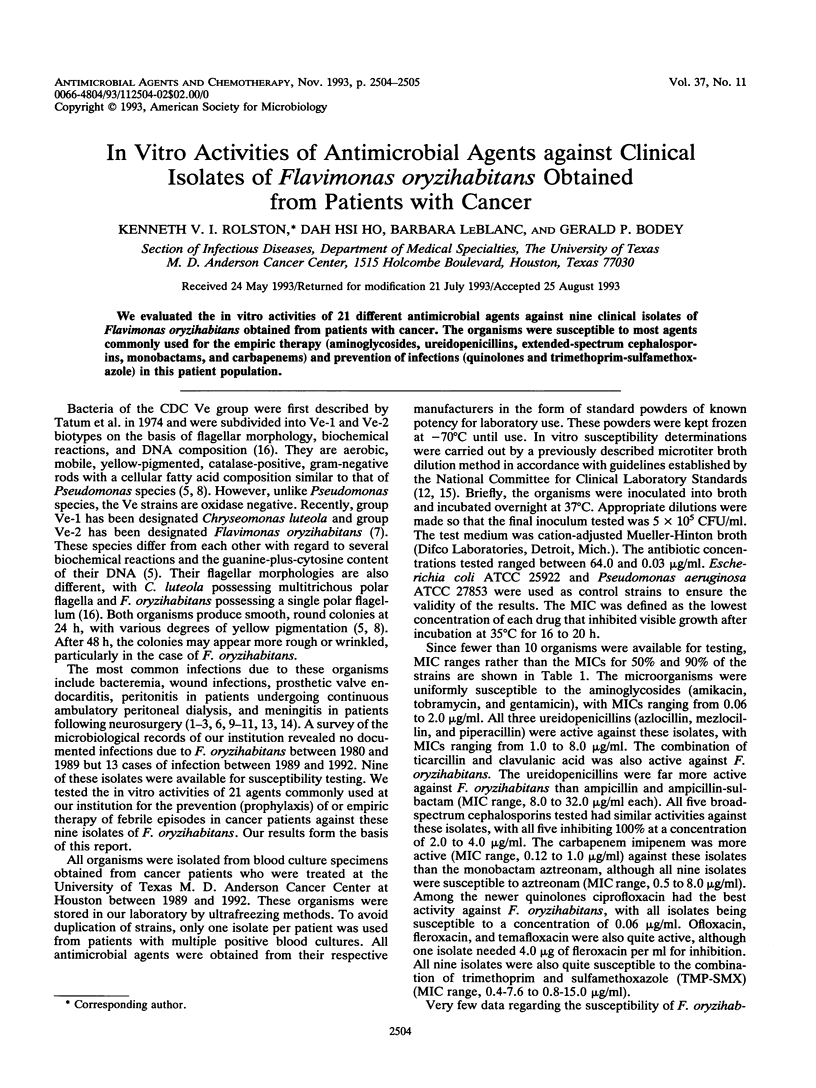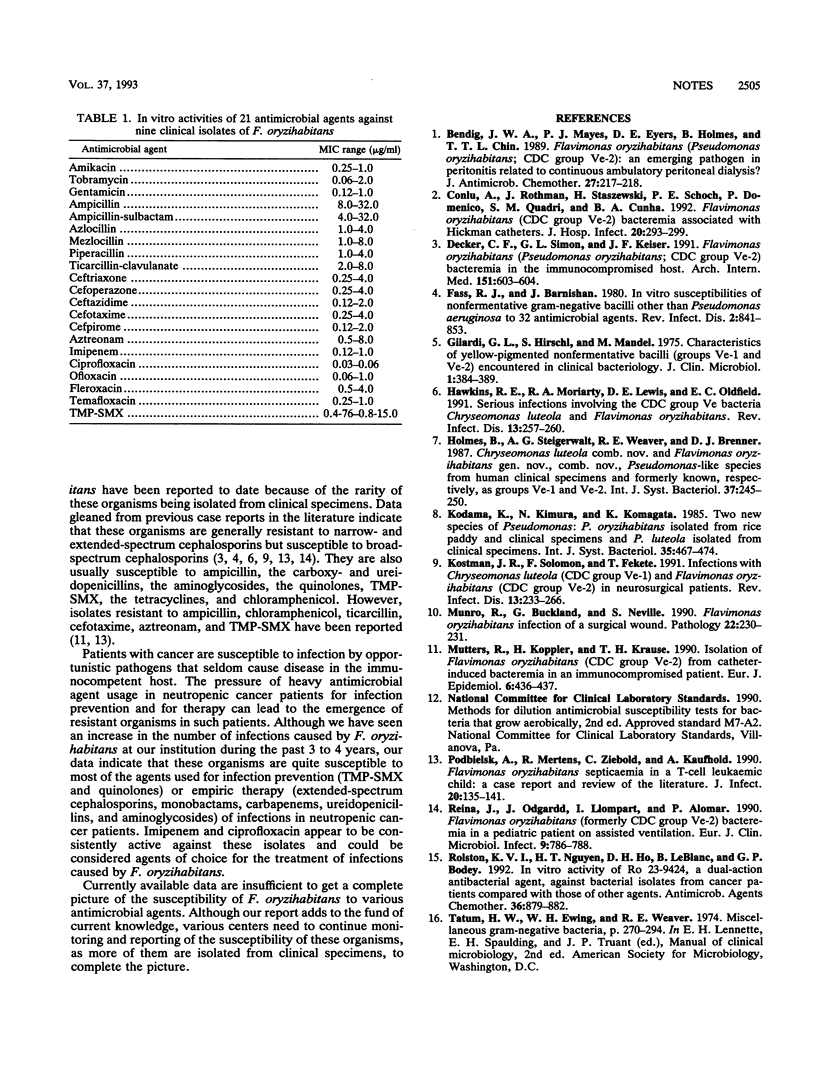Abstract
We evaluated the in vitro activities of 21 different antimicrobial agents against nine clinical isolates of Flavimonas oryzihabitans obtained from patients with cancer. The organisms were susceptible to most agents commonly used for the empiric therapy (aminoglycosides, ureidopenicillins, extended-spectrum cephalosporins, monobactams, and carbapenems) and prevention of infections (quinolones and trimethoprim-sulfamethoxazole) in this patient population.
Full text
PDF

Selected References
These references are in PubMed. This may not be the complete list of references from this article.
- Bendig J. W., Mayes P. J., Eyers D. E., Holmes B., Chin T. T. Flavimonas oryzihabitans (Pseudomonas oryzihabitans; CDC group Ve-2): an emerging pathogen in peritonitis related to continuous ambulatory peritoneal dialysis? J Clin Microbiol. 1989 Jan;27(1):217–218. doi: 10.1128/jcm.27.1.217-218.1989. [DOI] [PMC free article] [PubMed] [Google Scholar]
- Conlu A., Rothman J., Staszewski H., Schoch P. E., Domenico P., Quadri S. M., Cunha B. A. Flavimonas oryzihabitans (CDC group Ve-2) bacteraemia associated with Hickman catheters. J Hosp Infect. 1992 Apr;20(4):293–299. doi: 10.1016/0195-6701(92)90007-9. [DOI] [PubMed] [Google Scholar]
- Decker C. F., Simon G. L., Keiser J. F. Flavimonas oryzihabitans (Pseudomonas oryzihabitans; CDC group Ve-2) bacteremia in the immunocompromised host. Arch Intern Med. 1991 Mar;151(3):603–604. [PubMed] [Google Scholar]
- Fass R. J., Barnishan J. In vitro susceptibilities of nonfermentative gram-negative bacilli other than Pseudomonas aeruginosa to 32 antimicrobial agents. Rev Infect Dis. 1980 Nov-Dec;2(6):841–853. doi: 10.1093/clinids/2.6.841. [DOI] [PubMed] [Google Scholar]
- Gilardi G. L., Hirschl S., Mandel M. Characteristics of yellow-pigmented nonfermentative bacilli (groups VE-1 and VE-2) encountered in clinical bacteriology. J Clin Microbiol. 1975 Apr;1(4):384–389. doi: 10.1128/jcm.1.4.384-389.1975. [DOI] [PMC free article] [PubMed] [Google Scholar]
- Hawkins R. E., Moriarty R. A., Lewis D. E., Oldfield E. C. Serious infections involving the CDC group Ve bacteria Chryseomonas luteola and Flavimonas oryzihabitans. Rev Infect Dis. 1991 Mar-Apr;13(2):257–260. doi: 10.1093/clinids/13.2.257. [DOI] [PubMed] [Google Scholar]
- Kostman J. R., Solomon F., Fekete T. Infections with Chryseomonas luteola (CDC group Ve-1) and Flavimonas oryzihabitans (CDC group Ve-2) in neurosurgical patients. Rev Infect Dis. 1991 Mar-Apr;13(2):233–236. doi: 10.1093/clinids/13.2.233. [DOI] [PubMed] [Google Scholar]
- Munro R., Buckland G., Neville S. Flavimonas oryzihabitans infection of a surgical wound. Pathology. 1990 Oct;22(4):230–231. doi: 10.3109/00313029009086668. [DOI] [PubMed] [Google Scholar]
- Mutters R., Köppler H., Krause T. Isolation of Flavimonas oryzihabitans (CDC group Ve-2) from catheter-induced bacteremia in an immunocompromised patient. Eur J Epidemiol. 1990 Dec;6(4):436–437. doi: 10.1007/BF00151722. [DOI] [PubMed] [Google Scholar]
- Podbielski A., Mertens R., Ziebold C., Kaufhold A. Flavimonas oryzihabitans septicaemia in a T-cell leukaemic child: a case report and review of the literature. J Infect. 1990 Mar;20(2):135–141. doi: 10.1016/0163-4453(90)93366-z. [DOI] [PubMed] [Google Scholar]
- Reina J., Odgardd J., Llompart I., Alomar P. Flavimonas oryzihabitans (formerly CDC group Ve-2) bacteremia in a pediatric patient on assisted ventilation. Eur J Clin Microbiol Infect Dis. 1990 Oct;9(10):786–788. doi: 10.1007/BF02184698. [DOI] [PubMed] [Google Scholar]
- Rolston K. V., Nguyen H. T., Ho D. H., LeBlanc B., Bodey G. P. In vitro activity of Ro 23-9424, a dual-action antibacterial agent, against bacterial isolates from cancer patients compared with those of other agents. Antimicrob Agents Chemother. 1992 Apr;36(4):879–882. doi: 10.1128/aac.36.4.879. [DOI] [PMC free article] [PubMed] [Google Scholar]


